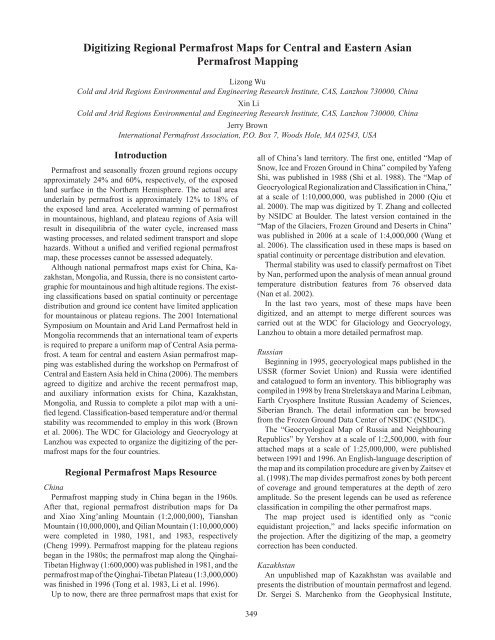Ninth International Conference on Permafrost ... - IARC Research
Ninth International Conference on Permafrost ... - IARC Research
Ninth International Conference on Permafrost ... - IARC Research
You also want an ePaper? Increase the reach of your titles
YUMPU automatically turns print PDFs into web optimized ePapers that Google loves.
Digitizing Regi<strong>on</strong>al <strong>Permafrost</strong> Maps for Central and Eastern Asian<strong>Permafrost</strong> MappingLiz<strong>on</strong>g WuCold and Arid Regi<strong>on</strong>s Envir<strong>on</strong>mental and Engineering <strong>Research</strong> Institute, CAS, Lanzhou 730000, ChinaXin LiCold and Arid Regi<strong>on</strong>s Envir<strong>on</strong>mental and Engineering <strong>Research</strong> Institute, CAS, Lanzhou 730000, ChinaJerry Brown<str<strong>on</strong>g>Internati<strong>on</strong>al</str<strong>on</strong>g> <strong>Permafrost</strong> Associati<strong>on</strong>, P.O. Box 7, Woods Hole, MA 02543, USAIntroducti<strong>on</strong><strong>Permafrost</strong> and seas<strong>on</strong>ally frozen ground regi<strong>on</strong>s occupyapproximately 24% and 60%, respectively, of the exposedland surface in the Northern Hemisphere. The actual areaunderlain by permafrost is approximately 12% to 18% ofthe exposed land area. Accelerated warming of permafrostin mountainous, highland, and plateau regi<strong>on</strong>s of Asia willresult in disequilibria of the water cycle, increased masswasting processes, and related sediment transport and slopehazards. Without a unified and verified regi<strong>on</strong>al permafrostmap, these processes cannot be assessed adequately.Although nati<strong>on</strong>al permafrost maps exist for China, Kazakhstan,M<strong>on</strong>golia, and Russia, there is no c<strong>on</strong>sistent cartographicfor mountainous and high altitude regi<strong>on</strong>s. The existingclassificati<strong>on</strong>s based <strong>on</strong> spatial c<strong>on</strong>tinuity or percentagedistributi<strong>on</strong> and ground ice c<strong>on</strong>tent have limited applicati<strong>on</strong>for mountainous or plateau regi<strong>on</strong>s. The 2001 <str<strong>on</strong>g>Internati<strong>on</strong>al</str<strong>on</strong>g>Symposium <strong>on</strong> Mountain and Arid Land <strong>Permafrost</strong> held inM<strong>on</strong>golia recommends that an internati<strong>on</strong>al team of expertsis required to prepare a uniform map of Central Asia permafrost.A team for central and eastern Asian permafrost mappingwas established during the workshop <strong>on</strong> <strong>Permafrost</strong> ofCentral and Eastern Asia held in China (2006). The membersagreed to digitize and archive the recent permafrost map,and auxiliary informati<strong>on</strong> exists for China, Kazakhstan,M<strong>on</strong>golia, and Russia to complete a pilot map with a unifiedlegend. Classificati<strong>on</strong>-based temperature and/or thermalstability was recommended to employ in this work (Brownet al. 2006). The WDC for Glaciology and Geocryology atLanzhou was expected to organize the digitizing of the permafrostmaps for the four countries.Regi<strong>on</strong>al <strong>Permafrost</strong> Maps ResourceChina<strong>Permafrost</strong> mapping study in China began in the 1960s.After that, regi<strong>on</strong>al permafrost distributi<strong>on</strong> maps for Daand Xiao Xing’anling Mountain (1:2,000,000), TianshanMountain (10,000,000), and Qilian Mountain (1:10,000,000)were completed in 1980, 1981, and 1983, respectively(Cheng 1999). <strong>Permafrost</strong> mapping for the plateau regi<strong>on</strong>sbegan in the 1980s; the permafrost map al<strong>on</strong>g the Qinghai-Tibetan Highway (1:600,000) was published in 1981, and thepermafrost map of the Qinghai-Tibetan Plateau (1:3,000,000)was finished in 1996 (T<strong>on</strong>g et al. 1983, Li et al. 1996).Up to now, there are three permafrost maps that exist forall of China’s land territory. The first <strong>on</strong>e, entitled “Map ofSnow, Ice and Frozen Ground in China” compiled by YafengShi, was published in 1988 (Shi et al. 1988). The “Map ofGeocryological Regi<strong>on</strong>alizati<strong>on</strong> and Classificati<strong>on</strong> in China,”at a scale of 1:10,000,000, was published in 2000 (Qiu etal. 2000). The map was digitized by T. Zhang and collectedby NSIDC at Boulder. The latest versi<strong>on</strong> c<strong>on</strong>tained in the“Map of the Glaciers, Frozen Ground and Deserts in China”was published in 2006 at a scale of 1:4,000,000 (Wang etal. 2006). The classificati<strong>on</strong> used in these maps is based <strong>on</strong>spatial c<strong>on</strong>tinuity or percentage distributi<strong>on</strong> and elevati<strong>on</strong>.Thermal stability was used to classify permafrost <strong>on</strong> Tibetby Nan, performed up<strong>on</strong> the analysis of mean annual groundtemperature distributi<strong>on</strong> features from 76 observed data(Nan et al. 2002).In the last two years, most of these maps have beendigitized, and an attempt to merge different sources wascarried out at the WDC for Glaciology and Geocryology,Lanzhou to obtain a more detailed permafrost map.RussianBeginning in 1995, geocryological maps published in theUSSR (former Soviet Uni<strong>on</strong>) and Russia were identifiedand catalogued to form an inventory. This bibliography wascompiled in 1998 by Irena Streletskaya and Marina Leibman,Earth Cryosphere Institute Russian Academy of Sciences,Siberian Branch. The detail informati<strong>on</strong> can be browsedfrom the Frozen Ground Data Center of NSIDC (NSIDC).The “Geocryological Map of Russia and NeighbouringRepublics” by Yershov at a scale of 1:2,500,000, with fourattached maps at a scale of 1:25,000,000, were publishedbetween 1991 and 1996. An English-language descripti<strong>on</strong> ofthe map and its compilati<strong>on</strong> procedure are given by Zaitsev etal. (1998).The map divides permafrost z<strong>on</strong>es by both percentof coverage and ground temperatures at the depth of zeroamplitude. So the present legends can be used as referenceclassificati<strong>on</strong> in compiling the other permafrost maps.The map project used is identified <strong>on</strong>ly as “c<strong>on</strong>icequidistant projecti<strong>on</strong>,” and lacks specific informati<strong>on</strong> <strong>on</strong>the projecti<strong>on</strong>. After the digitizing of the map, a geometrycorrecti<strong>on</strong> has been c<strong>on</strong>ducted.KazakhstanAn unpublished map of Kazakhstan was available andpresents the distributi<strong>on</strong> of mountain permafrost and legend.Dr. Sergei S. Marchenko from the Geophysical Institute,349
















